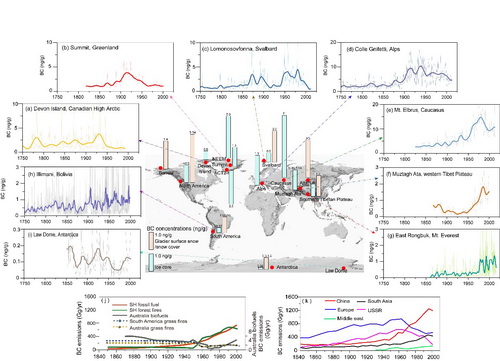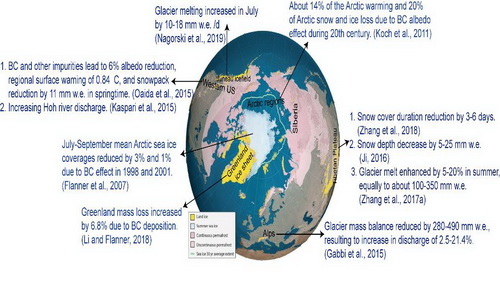Black Carbon in Snow and Ice Enhances Glacier and Snow Melting
Updatetime:2020-11-12From:
【Enlarge】【Reduce】
Black carbon (BC) is considered to be an important short-lived climate forcer. BC can darken the snow/ice surface, affect the energy balance, and hasten the melting of glaciers and snow.
Currently, by reviewing the recent published literatures, Prof. KANG Shichang, from the Northwest Institute of Eco-Environment and Resources (NIEER), Chinese Academy of Sciences (CAS), and his team presented an overview of the historical changes, spatial distribution of BC in snow/ice, and how these changes were related to the cryospheric melting.
In this study, they revealed that ice core records showed a rapid increase of BC concentrations that began in the 1850s and continued throughout the 20th century (Fig. 1).
In the global scale, radiative forcing (RF) induced by BC in snow and ice ranged from several W m–2 in fresh snow to hundreds of W m–2, with highest in the mid-latitudes. BC-in-snow can lead to an acceleration in the total glacier melt (approximately 20%) and/or a reduction in the duration of the snow cover by several days (Fig. 2).
Meanwhile, Prof. KANG also pointed out that given limited understanding of quantifying the role of BC in glacier and snow melting.
The work is funded by the second Tibetan Plateau Scientific Expedition and Research Program (STEP) (2019QZKK0605), the Strategic Priority Research Program of the Chinese Academy of Sciences (XDA19070501, XDA20040500), the National Natural Science Foundation of China (41671067, 41630754), the CAS "Light of West China" Program.
This work has been published on “Earth Science Reviews” recently entitle with “A review of black carbon in snow and ice and its impact on the cryosphere”. Prof. KANG Shichang and Dr. ZHANG Yulan are the first and corresponding author, respectively.

Fig. 1 Historical records of BC concentrations from ice cores (a-i), history of BC emissions for southern hemisphere (j) and norther hemisphere (k), and spatial distributions of average BC concentrations in snow (firn) on the glacier surface and in snow cover (center). (Image by Dr. ZHANG)

Fig. 2 Brief summary of the potential effects of BC in snow/ice in different cryospheric regions. (Image by Dr. ZHANG)
Contact:
ZHANG Yulan
E-mail: yulan.zhang@lzb.ac.cn
State Key Laboratory of Cryospheric Sciences, Northwest Institute of Eco-Environment and Resources, Chinese Academy of Sciences (CAS), Lanzhou 730000, China.
Appendix




